 Today's post begins a three-part interview with Curt Sauer, superintendent of Joshua Tree National Park. A veteran of the National Park Service, Curt has been at his current job for five years.
Today's post begins a three-part interview with Curt Sauer, superintendent of Joshua Tree National Park. A veteran of the National Park Service, Curt has been at his current job for five years.Allison: Curt, tell us about your background.
Curt: I've been with the National Park Service for 32 years--at Rocky Mountain National Park and then at the Grand Canyon as a backcountry ranger, dispatcher, and at the river unit for three years. I was transferred to Olympic National Park where I was the chief ranger for nine years. I enrolled in an executive development program to apply for superintendency, then applied for this job when it came up.
Allison: What was it like to work in the Cascade Mountains for all those years and then move to the desert?
Curt: I came to Joshua Tree National Park five years ago, during a drought. Before my family came down, on weekends I rented a car and drove into the park and went hiking. One day when I was hiking in the Pinto Y Arrastra, I sat down to rest and noticed a lizard eating a blade of grass. When I looked up at the hillside, I noticed the green there, too. It took my mind three weeks to look at the desert and see the green.
Allison: As superintendent of JTNP, what are your responsibilities?
Curt: To make sure that the park is taken care of, to see that the visitors enjoy themselves. It's like running a little town. We maintain the roads, dispose of waste in the campgrounds, and are in charge of maintenance and operations and of interpretive operation. We're in charge of law enforcement in the park--things like speeding, drugs, domestic disputes, and the poaching of reptiles. We manage natural and cultural resources, and administration for 90 employees.
Allison: What is a typical workday like?
Curt: There's no such thing as a typical workday in the National Park Service, which is why this is such a great job. As part of my job, I also attend meetings where I have the oportunity to talk to the public and work with the community and our partners.
Allison: What are the most frequently visited sites at the park?
Curt: I'd say the Wonderland of Rocks. The entrance is near the Wall Street Mill. Also, Barker Dam, the Hidden Valley nature trails, and the Cholla Garden. The park's best-kept secret is Keys Ranch, which offers tours. Most people visit the western side of the park. Wildflowers bloomed earlier this spring in Pinto Valley at the east end of the park, too.
Allison: How many visitors come to the park each year?
Curt: Each year Joshua Tree National Park sees 1.25 million visitors.
In Part II of this post Curt will share his concerns regarding Joshua Tree National Park. In Part III Curt will talk about what he takes pride in. Stay tuned!

No comments:
Post a Comment